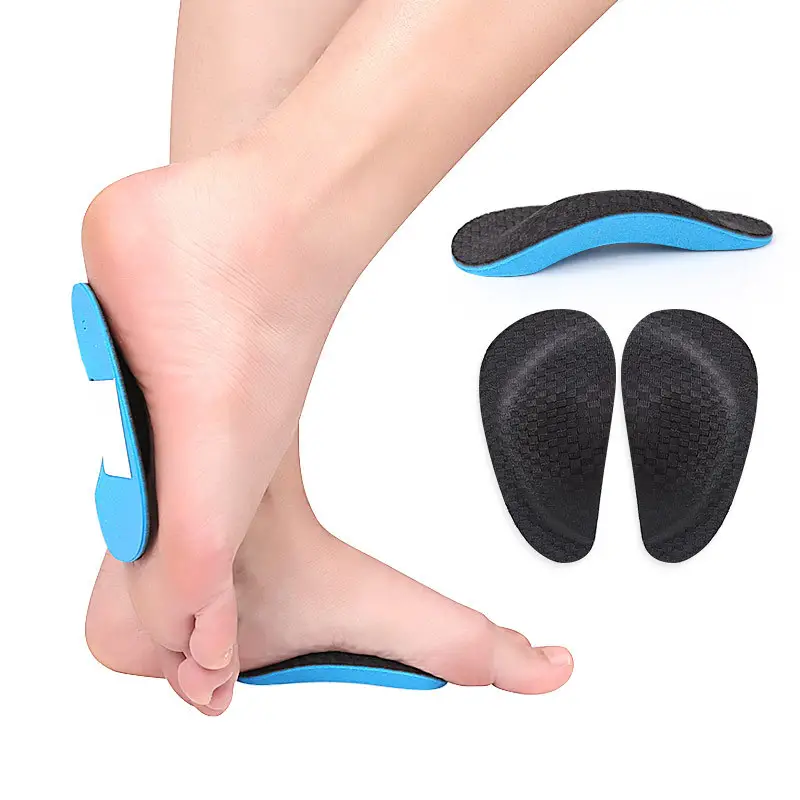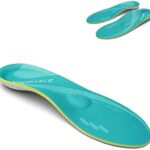Ensuring the health and comfort of your feet is essential for overall well-being. When it comes to foot care, selecting the right arch support products can make a significant difference. Whether you’re an athlete aiming to enhance performance, someone who spends prolonged periods on their feet at work, or simply looking for ways to alleviate discomfort, this comprehensive guide is here to assist you.
In this informative guide, we will explore a wide range of top-notch arch support products that have been carefully curated to cater to diverse needs. Alongside detailed product recommendations, we will delve into the reasons why proper arch support matters and how it can impact your daily life positively.
Our goal is to equip you with the knowledge and insights needed to make informed decisions about the best arch support products for your unique requirements. From arch support insoles to orthopedic shoes, compression socks, and more, we’ll cover it all. Additionally, we’ve compiled a list of frequently asked questions (FAQs) to address common queries and ensure that you have a comprehensive understanding of this critical aspect of foot health.
So, if you’re ready to take a step towards improved comfort, reduced foot pain, and better overall posture, let’s embark on this informative journey to discover the best arch support products on the market.
Article Outline
Factors to Consider When Choosing Arch Support
- Foot Type and Arch Shape
- Material and Durability
- Comfort and Fit
- Specific Needs (e.g., sports, daily wear, medical conditions)
Top Arch Support Brands and Products
- Brand 1: Atlas Arch Support
Overview and Popular Products - Brand 2: Superfeet Green Insoles
Overview and Popular Products - Brand 3: Powerstep Pinnacle Insoles
Overview and Popular Products
How to Care for Your Arch Support Products
- Cleaning and Maintenance Tips
- When to Replace Them
WHERE TO BUY
Factors to Consider When Choosing Arch Support
Foot Type and Arch Shape
- Normal Arch (Medium Arch): If you have a normal arch, your foot likely has a balanced and proportional shape. This type offers moderate natural arch support. However, even with a normal arch, comfort and additional support from arch support products can be beneficial, especially during prolonged standing or physical activities.
- Flat Arch (Low Arch or Fallen Arch): Flat feet are characterized by a very low or absent arch, leading to more of the foot surface making contact with the ground. People with flat arches are prone to overpronation (excessive inward rolling of the foot), which can lead to various issues like heel pain, plantar fasciitis, and knee pain. Arch support products for flat feet typically aim to provide structure and prevent overpronation.
- High Arch: High arches are the opposite of flat feet, where the arch is raised more than normal. This arch type often leads to underpronation (insufficient inward rolling of the foot), leading to excessive pressure on the smaller toes and outer edge of the foot. People with high arches often require arch support products that offer cushioning and help distribute pressure more evenly.
- For Normal Arches: Look for moderate arch support that maintains the natural shape of your foot. Insoles or orthotics designed for stability and comfort are usually a good choice.
- For Flat Arches: Seek arch support products that provide firm support and help control overpronation. Custom orthotics or over-the-counter insoles with a structured arch and a deep heel cup can be beneficial.
- For High Arches: Cushioning is key for high arches. Look for products that provide ample cushioning and are designed to absorb shock. Arch supports that help distribute your body weight more evenly across your foot can reduce pressure on the forefoot and heel.
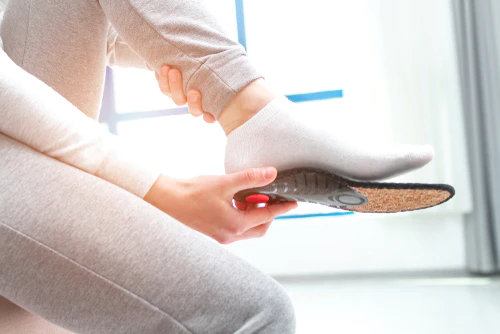
Material and Durability
- Memory Foam: Memory foam molds to the shape of your foot, providing personalized comfort and cushioning. It’s excellent for pressure relief but may compress over time, reducing its support capabilities. Memory foam is ideal for everyday comfort but may not be the best for rigorous activities.
- Gel: Gel insoles or inserts offer excellent shock absorption, making them a popular choice for high-impact activities. They tend to be durable and maintain their shape and support over time. However, they might not offer as much arch-specific support as other materials.
- EVA (Ethylene-vinyl acetate): EVA is a lightweight, foam-like material known for its cushioning properties. It’s commonly used in running shoes and orthotic insoles. EVA provides a balance of support and flexibility, but it may compress with prolonged use.
- Polyurethane: Polyurethane is more durable and offers greater support than memory foam or EVA. It’s often used in orthotics for its longevity and ability to maintain its shape and support over time. However, it can be less cushioning and more rigid, which might not be suitable for everyone.
- Leather: Leather insoles are known for their durability and natural breathability. They can offer moderate arch support and are often used in dress shoes. Leather molds to the shape of your foot over time, providing a custom fit. However, leather might not provide as much cushioning or shock absorption as other materials.
- Plastics or Carbon Fiber: These materials are often used in custom orthotics prescribed by podiatrists. They are highly durable and provide excellent arch support. While they offer superior longevity, they are usually the least flexible and cushioning, making them more suitable for specific medical conditions rather than general comfort.
Durability Considerations
- Frequency of Use: Materials like EVA and memory foam may wear out faster with daily use, especially in high-impact activities.
- Weight and Activity Level: Heavier individuals or those engaged in high-impact sports might benefit from more durable materials like polyurethane or carbon fiber.
- Maintenance: Proper care can extend the life of arch support products. For instance, allowing insoles to air out and cleaning them regularly can prevent material breakdown.
- Replacement Frequency: Most arch support products, especially those made from softer materials, should be replaced regularly, depending on the level of use and visible wear.
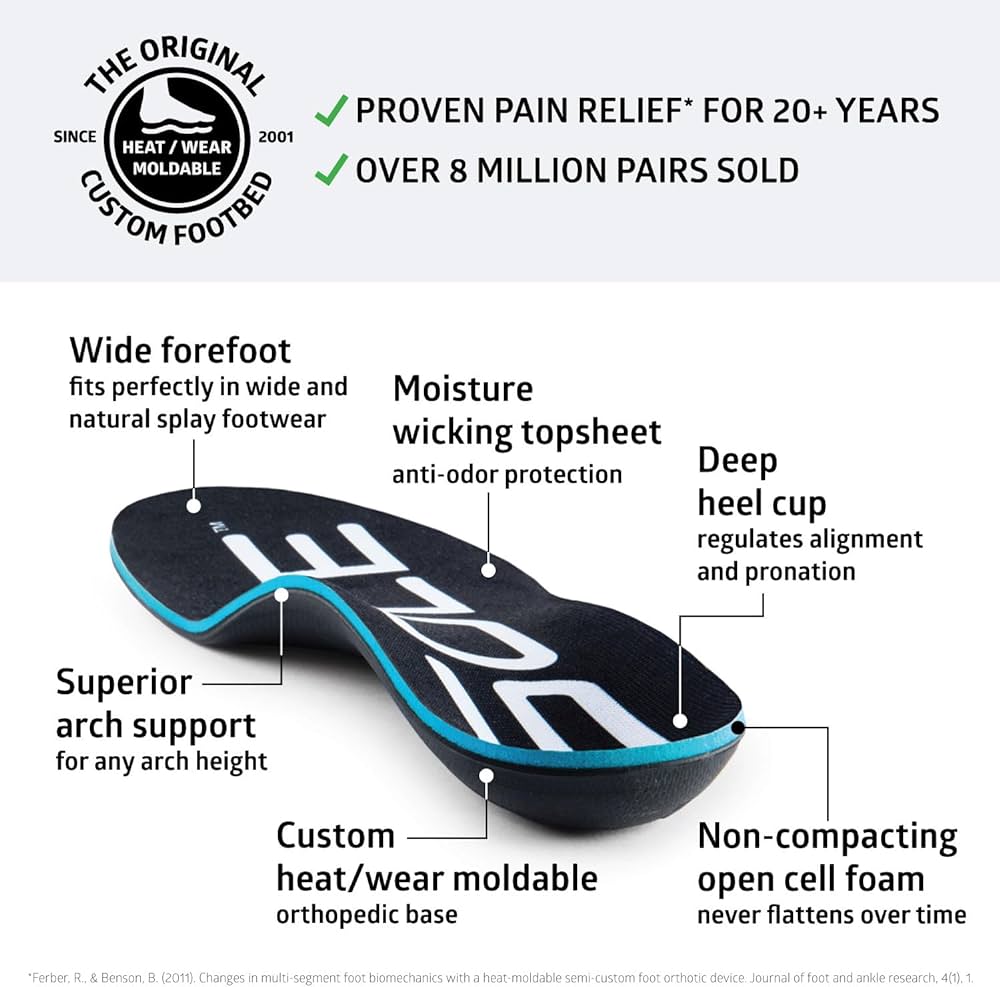
Comfort and Fit
Comfort and fit are paramount when selecting arch support products. The right fit not only ensures maximum comfort but also plays a crucial role in the effectiveness of the arch support. Here are key aspects to consider for achieving the best comfort and fit:
- Accurate Sizing: Arch supports should match your shoe size closely. Many products come in a range of sizes, and some can be trimmed for a more precise fit. Ensure that the arch support aligns properly with the arch of your foot; it shouldn’t be too short or extend beyond your heel or toes.
- Foot Width and Volume: Consider the width of your foot and the volume of the shoe. Some insoles are designed for wide feet or high-volume shoes (like boots), while others are better suited for narrow feet or low-volume shoes (like dress shoes).
- Arch Type Compatibility: Choose an arch support that matches your arch type – low, medium, or high. Using the wrong type can lead to discomfort and other foot issues. For example, someone with a high arch using a flat insole might not receive adequate support.
- Material for Comfort: The material of the arch support affects comfort. Memory foam and gel provide cushioning and are great for shock absorption but might not offer the firm support needed for specific conditions. Firmer materials like polyurethane or carbon fiber provide more structured support.
- Flexibility vs. Rigidity: Depending on your needs, you might require a more flexible or more rigid arch support. More rigid materials offer greater control and support, which is beneficial for certain foot conditions. Flexible materials allow for more foot movement, which might be preferable for everyday comfort.
- Adaptation Period: It’s normal to require an adaptation period for new arch support. Start by wearing them for a few hours a day, gradually increasing the time as your feet adjust.
- Shoe Compatibility: Ensure the arch supports fit well in your shoes. They shouldn’t cause your shoes to feel overly tight or change the way your foot fits inside the shoe. Some insoles are designed for specific types of shoes (like athletic shoes, dress shoes, or boots).
- Activity-Specific Features: Consider the activities you’ll be doing. Athletes might need different arch support than what’s required for everyday walking or standing. Look for features like moisture-wicking materials or extra cushioning in high-impact areas if needed.
- Customization Options: For those with specific foot conditions or unusual arch shapes, custom-made orthotics might be the best option. They are tailored to your feet’s exact specifications, offering the best fit and comfort.
Specific Needs (e.g., sports, daily wear, medical conditions)
For Sports Activities
- High Impact Sports: Activities like running, basketball, or soccer require arch support with excellent shock absorption and stability. Look for insoles designed for high impact, which often feature durable materials like gel or reinforced plastics.
- Endurance Sports: For sports like long-distance running or cycling, you might prefer arch supports that offer a balance between cushioning and support, with an emphasis on comfort over long periods.
- Sport-Specific Design: Some arch supports are tailored for specific sports, taking into account the unique foot movements and pressures involved.
For Daily Wear
- Comfort for Prolonged Standing: If your daily routine involves standing for long hours, look for arch supports that provide cushioning and support, helping to reduce fatigue and discomfort.
- Versatile Use: For general daily wear, choose arch supports that are versatile and can fit into different shoe types comfortably, from casual shoes to work boots.
- Material Breathability: Consider materials that are breathable, especially if you wear the arch supports all day, to maintain foot hygiene and comfort.
For Medical Conditions
- Plantar Fasciitis and Heel Pain: Specialized arch supports are available for conditions like plantar fasciitis, featuring deep heel cups and firm arch support to alleviate pain.
- Diabetic Foot Care: Those with diabetes might require arch supports made from softer, non-irritating materials to prevent foot ulcers and enhance circulation.
- Flat Feet or Overpronation: Look for arch supports that provide structured support to correct foot posture and alleviate the stress caused by flat feet or overpronation.
- Arthritis and Joint Pain: In cases of arthritis, cushioning and shock absorption are crucial to reduce the stress on joints.
Additional Tips
- Consult a Professional: If you have specific medical conditions or unique foot care needs, it’s advisable to consult a podiatrist or foot care specialist. They can provide personalized recommendations and might suggest custom orthotics.
- Trial and Adaptation: It may take some trial and error to find the perfect match for your specific needs. Be prepared to try multiple options and give yourself time to adapt to each new arch support.
- Quality and Durability: Invest in high-quality products that offer durability and effectiveness, especially if you require arch supports for medical reasons or intense sports activities.
Top Arch Support Brands and Products
Atlas Arch Support

Description: Atlas Arch Support likely offers products designed to provide support and comfort to the arch of the foot. These products might be insoles, orthotic devices, or specialized footwear. They are usually crafted with materials that offer both firm support and cushioning, like memory foam, gel, or reinforced plastic. The design might be tailored to fit various shoe types, from athletic shoes to formal wear. These products may also feature advanced technologies for better fit, breathability, and durability.
Ideal For:
- Individuals with Foot Conditions: People suffering from flat feet, plantar fasciitis, or other arch-related issues would find these products beneficial.
- Athletes: Athletes who engage in high-impact sports might use them for additional arch support and to reduce the risk of injuries.
- Long Periods of Standing or Walking: Those whose jobs require standing or walking for long hours would benefit from the added support and comfort.
- General Foot Health: Even individuals without specific foot problems might use these products for improved comfort and to maintain good foot health.
Superfeet Green Insoles
- Description: Superfeet is renowned for its wide range of insoles catering to different foot types and needs. The Superfeet Green model is particularly popular, known for its durable construction and versatile design. It’s suitable for high arches and provides excellent support and shock absorption, making it a good choice for both athletic and everyday shoes.
- Ideal For: Those seeking firm support, high arch individuals, and users engaging in high-impact sports or prolonged standing.

Powerstep Pinnacle Insoles
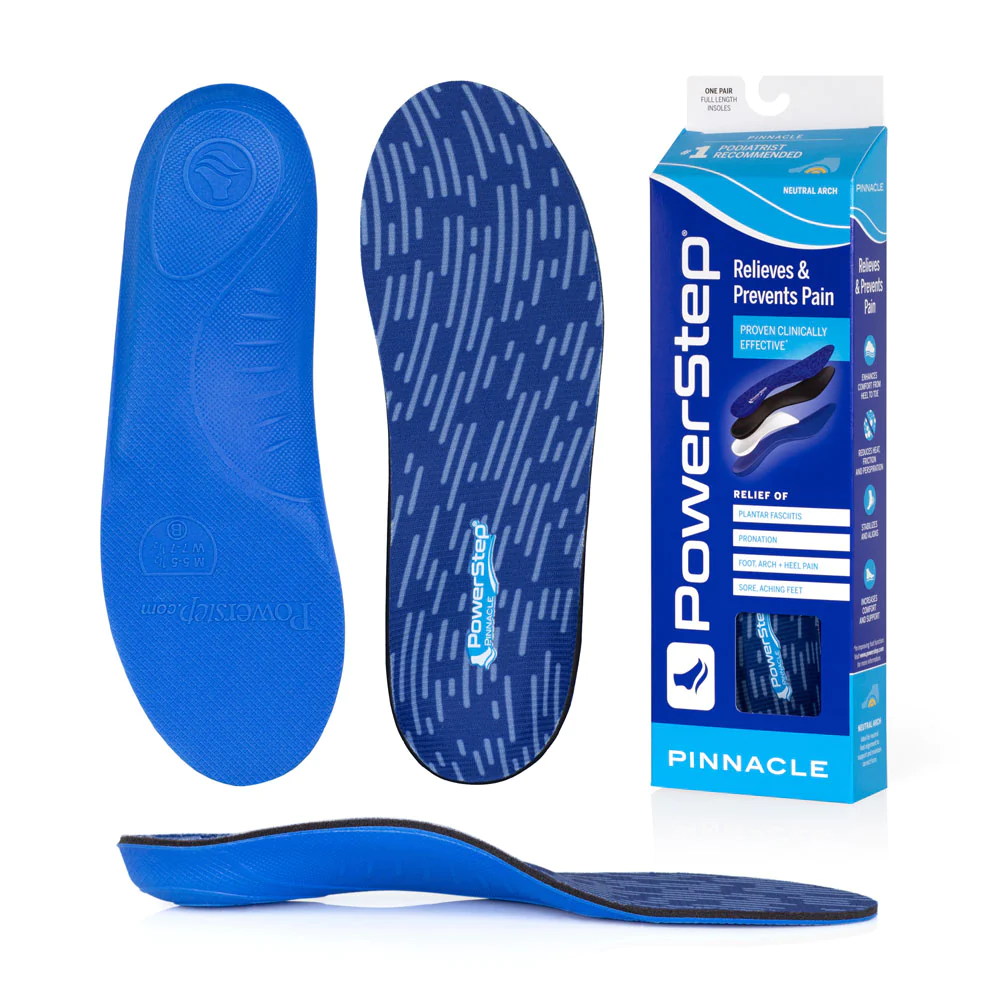
- Description: Powerstep offers orthotic insoles designed by podiatrists. The Pinnacle model is highly regarded for its balance of cushioning and support. It features a strong, medical-grade foot support encapsulated in a double-layer cushioning. These insoles are ideal for relieving foot pain and providing comfort for various foot conditions.
- Ideal For: Individuals with foot pain, those requiring extra cushioning, and people with conditions like plantar fasciitis or flat feet.
How to Care for Your Arch Support Products
Cleaning and Maintenance Tips
Maintaining and cleaning your arch support products is essential for their longevity and effectiveness. Here are some tips to keep them in top condition:
- Regular Inspection: Regularly check your arch supports for signs of wear and tear. Look for any flattening, cracks, or changes in shape. This is especially important for products used daily or for athletic activities.
- Cleaning Process:
- Insoles and Inserts: Remove them from your shoes. Use a mild soap and warm water to gently clean the surface. Avoid soaking them completely. Instead, use a damp cloth or sponge.
- Orthotic Shoes: For shoes, use a soft brush or cloth to remove surface dirt. If they have removable insoles, clean them separately as mentioned above.
- Drying: Never expose arch support products to direct heat or sunlight for drying. Instead, let them air dry naturally. Place them in a well-ventilated area, away from direct heat sources.
- Deodorizing: To keep your arch support products smelling fresh, sprinkle baking soda on them overnight and shake it off in the morning. You can also use a foot spray designed for deodorizing shoes and insoles.
- Rotation: If possible, have more than one pair of arch supports or orthotic shoes. Rotating them will allow each pair to rest and air out, reducing the risk of accumulating moisture and odors.
- Storage: When not in use, store your arch support products in a cool, dry place. Avoid cramped spaces where they might get bent or misshapen.
- Avoid Machine Washing and Drying: Unless explicitly stated by the manufacturer, avoid machine washing or drying your arch support products, as this can damage their structure and material.
- Check for Compatibility with Shoes: Ensure that your arch supports fit well within your shoes. Ill-fitting arch supports can get damaged quickly and may not provide the necessary support.
- Replacing When Needed: No arch support product lasts forever. Be prepared to replace them when they show significant signs of wear or no longer provide the necessary support.
When to Replace Them
Knowing when to replace your arch support products is crucial for maintaining foot health and comfort. Here are the key indicators that it’s time to get new arch supports:
- Visible Wear and Tear: If you notice significant signs of wear, such as cracks, tears, or the material thinning in key areas, it’s time to replace them. This wear can compromise the support they offer.
- Flattening or Deformation: Arch supports are designed to provide specific contours for support. If they start to flatten or lose their shape, they won’t be as effective in providing the necessary arch support.
- Reduced Comfort: When your arch supports no longer feel comfortable or you start experiencing discomfort in your feet, ankles, or legs, it could be a sign that the supports are no longer functioning properly.
- Changes in Foot Shape or Needs: Our feet can change over time due to factors like age, weight fluctuations, or health conditions. If your feet have changed, your current arch supports might not be appropriate anymore.
- Increased Foot Pain or Discomfort: If you start experiencing new or increased foot pain, it might be due to the diminished effectiveness of your arch supports. This is especially important for people with specific foot conditions, like plantar fasciitis.
- Worn Outsoles: If the outsoles of your orthotic shoes are worn out, it’s a good indication that the internal support structures might also be compromised.
- Recommendation from a Professional: If a healthcare professional or podiatrist recommends replacing your arch supports, it’s wise to follow their advice, as they can assess whether the supports are still suitable for your needs.
- Manufacturer’s Lifespan Recommendation: Check the manufacturer’s guidelines for the lifespan of the product. Many have a recommended replacement timeline which can be a useful reference.
- Ineffectiveness in Alleviating Problems: If your arch supports are no longer effective in alleviating the problems they were meant to address, such as arch pain or overpronation, it’s time for a new pair.
